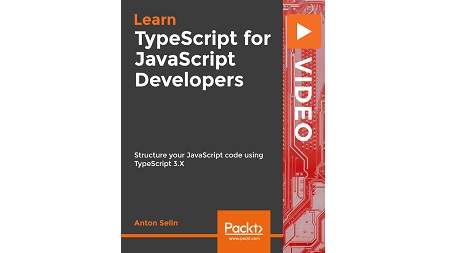
English | MP4 | AVC 1920×1080 | AAC 48KHz 2ch | 2h 54m | 392 MB
Migrate from JavaScript to TypeScript and write well-structured, statically-typed, and reusable code
TypeScript and JavaScript are must-know languages for many web developers. While JavaScript is the de facto choice for web development, this course will show you why you need TypeScript to make your code more efficient.
This course is designed to get you started with TypeScript and help you implement a variety of real-world coding examples. In this course, you will learn how to convert several JavaScript code samples into TypeScript and master how these relate to JavaScript. You will learn the essentials of TypeScript such as objects, functions, and classes and appreciate the similarities and differences between the JavaScript and TypeScript syntaxes. In addition, you will learn how to configure Typescript projects according to your needs and implement best practices.
By the end of this course, you will be confident to start your projects in TypeScript. You will have the skills you need to utilize TypeScript for writing better frontends for your web apps.
Learn
- Configure the TypeScript environment to run and transpile your code into JavaScript
- Implement basic TypeScript types to perform simple operations
- Structure code using interfaces to define the shape of objects effectively
- Write dynamic code with the help of generics
- Maintain a modular structure and reduce complexity using object-oriented programming
- Create dependencies using namespaces and modules
- Implement advanced types to help you define more specific types
Table of Contents
Introduction to TypeScript
1 The Course Overview
2 TypeScript History
3 Performing Simple Operations Using Basic Types
4 Writing Your First Code Using TypeScript
Configuring TypeScript Project
5 Overview of the Ecosystem
6 Setting Up TypeScript Environment
7 Compilation Options and tsconfig.json
8 Linter and Watch Mode
9 Best Practices
Objects Using Classes and Interfaces in TypeScript
10 Creating Classes
11 Encapsulation Using Modifiers
12 Getting and Setting Your Objects Using Accessors
13 Abstract Classes and Constructor Functions
14 Interfaces with Optional Properties
15 Extending Interfaces and Classes
16 Implementing Interfaces
Achieve Code Reusability Using Functions and Generics
17 Using Function Types
18 Modify Objects Using Function Parameters
19 Lexical ‘this’ Context
20 Reuse the Functions Using Overloads
21 Write a Simple Generic Function
22 Apply Limitations Using Generic Constraints
Maintain Dependency Using Modules and Namespaces
23 Implement Module Imports and Exports
24 Module Code Generation
25 Advanced Module Loading Scenarios
26 Organize Objects Using Namespacing
Use Advanced Types to Write Efficient Code
27 Apply Conditions Using Conditional Types
28 Group Your Types Using Intersection and Union Types
29 Type Guards and Differentiating Types
30 Nullable Types and Type Aliases
31 String and Numeric Literal Types
Resolve the captcha to access the links!